―
World Toilet Day
―
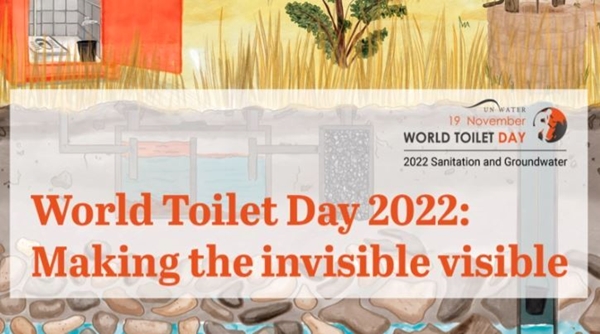
https://www.worldtoiletday.info/
What is World Toilet Day?
It is an international day designated by the U.N. In 2013, the United Nations officially designated November 19 as World Toilet Day.
Why did the peace-oriented UN set a day to commemorate the toilet? That is because the disease and safety risks caused by unsanitary toilet facilities are life-threatening. Let's take a look at toilets that threaten the lives of many people around the world.
―
6th target for world peace, Clean water and sanitation
―
At the UN General Assembly in 2015, the United Nations set Sustainable Development Goals (SDGs), or the 17 goals that must be achieved by 2030 for world peace.
(Go to the UN's Sustainable Development Goals website)
The sixth goal of the Sustainable Development Goals (SDGs) is Clean Water and Sanitation, which aims to ensure access to safe water and basic sanitation facilities (toilet) for all.
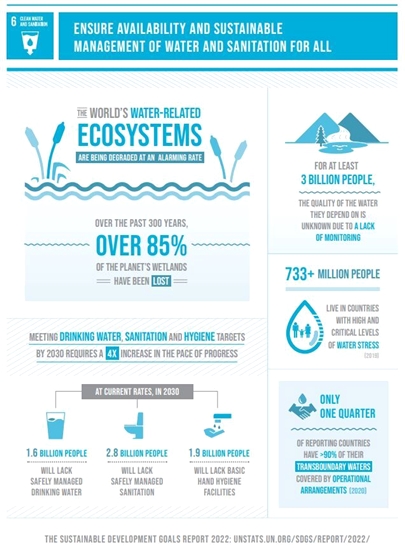
The second target of SDG 6 is related to toilet hygiene.
SDGs 6. Clean water and sanitation targets 6.1 By 2030, achieve universal and equitable access to safe and affordable drinking water for all. 6.2 By 2030, achieve access to adequate and equitable sanitation for all and end open defecation, paying special attention to the needs of women and girls and those in vulnerable situations 6.3 By 2030, improve water quality by reducing pollution, eliminating dumping and minimizing release of hazardous chemicals and materials, halving the proportion of untreated wastewater and substantially increasing recycling and safe reuse globally 6.4 By 2030, substantially increase water-use efficiency across all sectors and ensure sustainable withdrawals and supply of freshwater to address water scarcity and substantially reduce the number of people suffering from water scarcity. 6.5 By 2030, implement integrated water resources management at all levels, including through transboundary cooperation as appropriate 6.6 By 2020, protect and restore water-related ecosystems, including mountains, forests, wetlands, rivers, aquifers and lakes. |
http://www.sunhakpeaceprize.org/kr/news/issue.php?bgu=view&idx=584
(Read Sunhak Peace article about Clean Water and Sanitation)
What kind of problem does the bathroom pose in the sight of the UN?
The biggest problem is the impact on health. Various bacteria mixed with excrement dumped on roads, streams, and rivers cause water-borne infectious diseases such as cholera, dysentery, and polio.
If you contract severe diarrhea from a young age due to a water-borne infectious disease, you will suffer from malnutrition and be vulnerable to various diseases even as an adult.
According to the World Health Organization (WHO), about 1.5 million people die each year from water-borne diseases.

Toilets are also a matter of human dignity. Women and children where open defecation is the only option are at risk of sexual assault. It points out that, for this reason, in countries where school toilet facilities are poor, female students often drop out of school when menarche begins.
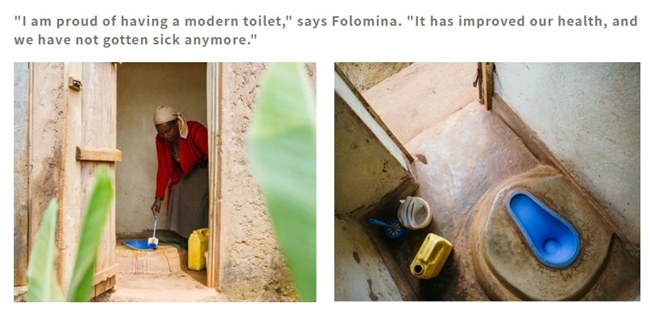
(Improved toilet facilities in a Rwanda family. Source: Water for People)
According to data from the non-governmental organization WaterAid, 170 million people worldwide live without toilets. And every two minutes, a child under the age of 5 dies from diarrhea caused by dirty water and poor toilet hygiene.
https://www.wateraid.org/uk/the-crisis/facts-and-statistics
Fortunately, the situation is gradually improving. According to the "Sustainable Development Goals Report" published by the UN in July this year, toilet hygiene is gradually improving thanks to the international community's efforts to provide access to clean toilets and good hygiene.
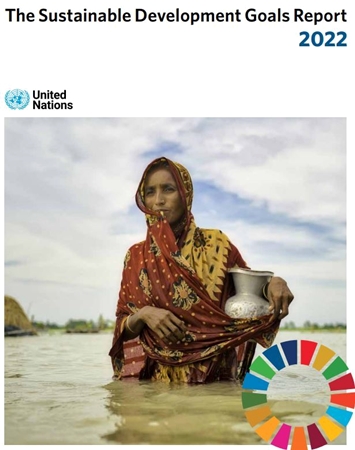
https://unstats.un.org/sdgs/report/2022/Goal-06/
According to the report, from 2015 to 2020, the number of people using safe and sanitary toilet facilities worldwide increased from 47% to 54%.
If this trend continues, it will reach 67% by 2030. Nevertheless, about 280 million people remain without access to sanitary toilet facilities. The United Nations has stated that in order to achieve the 2030 goal, improvement is needed at a rate four times faster than it is now.
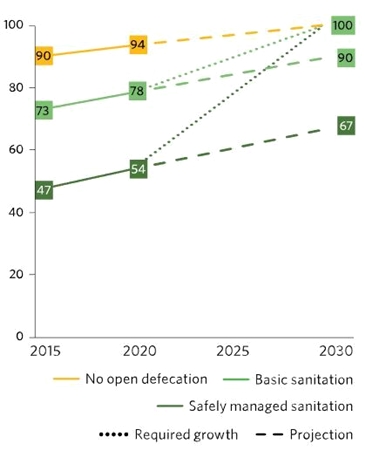
Over the same period, the number of people who defecate on the street decreased from 739 million to 494 million. The United Nations has analyzed that it is on track to end open defecation by 2030.
―
“No bathroom, no bride.”
Clean India Mission
“You don’t have a toilet? Then I won't marry you!!"
“Do you have toilets at home? Then we can get married."
It sounds a bit absurd, but it's a true story in India, where half of its 1.3 billion people defecate outdoors.
India is a representative country with poor toilet facilities. In response, the Indian government has been implementing the "Swachh Bharat Mission: Clean India" policy since October 2014, a movement to improve toilet hygiene: the goal is to become “Open Defecation Free."
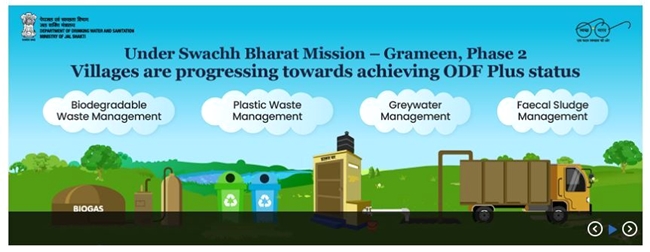
https://swachhbharatmission.gov.in/sbmcms/index.htm
As part of the Clean India movement, the Indian government launched a campaign with a unique slogan: “No Toilet, No Bride.”
This intriguing slogan campaign is said to have started in the northern Indian state of Haryana, which has actually created about 1.4 million new toilets across India as women refuse to marry men who can't afford them.

This story was the theme of the 2017 screenplay Toilet: A Love Story set in a rural village with no custom of having toilet facilities. The film begins when the bride about to get married to a young man in the village discovers the groom's house has no bathroom and threatens to run away. The groom struggles to persuade the villagers to build a toilet.
The Indian government is steadily improving toilet hygiene by providing funds to poor families to build toilets and by rewarding those who use the toilet or blowing a whistle when they see a person relieving themselves outdoors in an effort to eliminate the custom of urinating in public.
―
Chinese toilet roll
―
China also is pouring monumental efforts into improving toilet hygiene at the central government level. China started the 'toilet revolution' in 2015, and over the next 3 years it spent about 20 billion yuan ($2.8 billion USD) to renovate or build 70,000 toilets and add 64,000 by 2020. In addition, funds have gone to outfit public offices and public institutions with toilets open to the public.
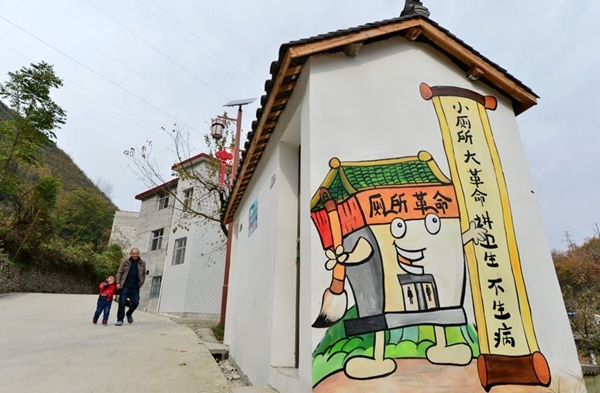
(China’s Hubei Province slogan: “Big revolution in small bathrooms:
If you pay attention to hygiene, you won’t get sick!”)
However, there are many reports that the results are not great compared to the efforts made by local governments, whereas big government commits such absurd boondoggles as installing flush toilets in places without water and sewage facilities, or building luxurious toilets equipped with TVs and refrigerators.
It is also reported that the old culture of allowing young children to defecate in the open is not readily changed.
―
Bill Gates: drinking water from feces
―

Bill Gates is famous for putting a lot of effort into improving bathrooms, as part of his collective effort to save countless lives that would otherwise die from water-borne diseases.
In 2011, the Bill & Melinda Gates Foundation launched the Reinvent Toilet Challenge (RT). The challenge is a real effort to improve toilet facilities in underdeveloped countries, to develop a toilet system that does not require water and sewage connections or electricity, is inexpensive, and can recycle excrement.
These efforts are inspired by the high cost of building and maintaining toilets, sewers and wastewater treatment systems in underdeveloped countries in sub-Saharan Africa and South Asia.
The Reinvent Toilet Challenge supports products that:
- Remove harmful bacteria from human excreta and recover valuable resources such as energy, clean water and nutrients
- Operate without connection to water and sewage and require minimal electricity
- Cost less than US$0.05 cents per user per day
- Promote sustainable and profitable sanitation services and businesses in poor urban settings
- Can appeal to both developed and developing countries. |
In 2014, a video of Bill Gates drinking water extracted from feces went viral. It's a video of drinking water made at a human waste processing facility called 'Janiciki Omniprocessor,' and there was even a quip that Bill Gates drank poop water from this place.
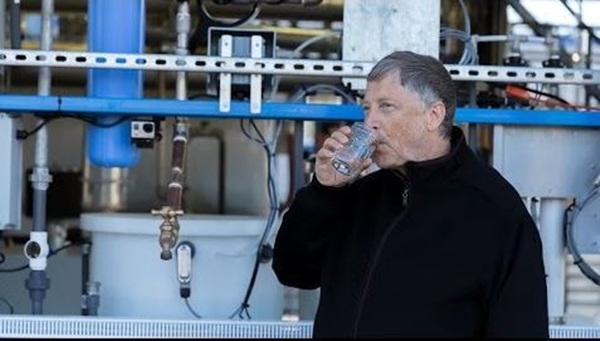
https://blog.education.nationalgeographic.org/2015/01/08/from-poop-to-potable-with-bill-gates/
The Omniprocessor separates the manure into steam and solids, uses the power of the steam to generate electricity, and burns the solids to ash. It also filters, condenses and distills steam to produce clean water. This pilot project is currently being pioneered in Dakar, Senegal.
https://en.reset.org/reinventing-toilet-piloting-janicki-omni-processor-dakar-senegal-01072020/
In August this year, Samsung Electronics in Korea, which has been collaborating on the Bill & Melinda Gates Foundation's toilet reinvention project, succeeded in developing a new concept toilet model that does not require water and sewage treatment, and announced that it plans to provide technology patents for free to underdeveloped countries.
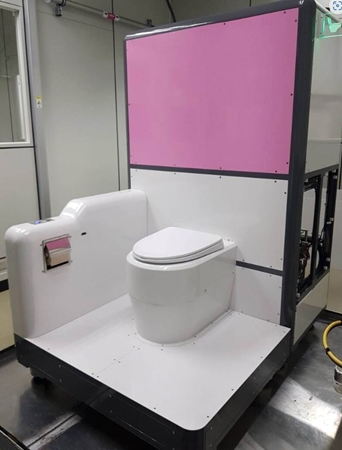
(New concept toilet model developed by Samsung Electronics)
―
Various types of sustainable toilets
―
● Handy Pod
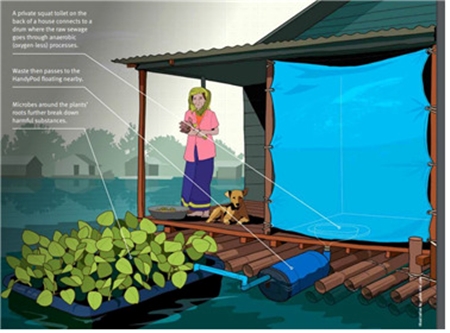
(Handy Pod Toilet: Source: Water Aid)
The Handy Pod is a device to solve the sewage problem for residents who live on the water or near lakes. This facility is actually being used in floating villages in Cambodia.
First, domestic sewage or excrement is sent into a drum where anaerobic microorganisms actively treat the waste. The device is designed to return the byproducts to an artificial wetland and decompose and absorb them through plants such as water hyacinths and various microorganisms. It is attracting attention, and if it is installed and used in every house, it will dramatically solve the problem of water pollution in the lake.
● Peepoo Bag
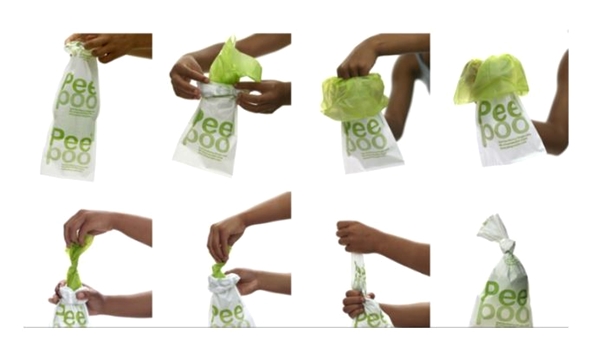
http://www.peepoople.com/peepoo/start-thinking-peepoo/
Peepoo Bag is a bioplastic bag developed by a Swedish company. The bag self-decomposes and the material inside the bag decompose the excrement to remove bacteria and transform it into a fertilizer ingredient, so all you have to do is bury it in the soil.
It's easy to use, so all you need is a space where you can personally do your business. Reports are that usability has been verified in Kenya's slums and Bangladesh.
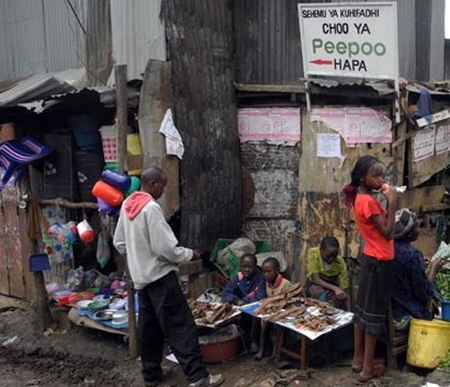
One person on average uses 45 liters of water a day to flush the toilet in one part of the world. Meanwhile, people in other parts of the world walk for hours to fetch water. And 3.6 billion people still do not have access to toilets and safe sanitation.
We can think about what actions to take so that everyone can enjoy the universal right to the toilet.
Written by Sharon Choi
Director of Planning
Sunhak Peace Prize Secretariat

